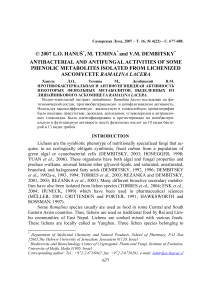Противобактериальная и антифунгицидная активность некоторых фенольных метаболитов, выделенных из лишайникового аскомицета Ramalina lacera.
Автор: Хануш Л.О., Темина М., Дембицкий В.М.
Журнал: Самарская Лука: проблемы региональной и глобальной экологии @ssc-sl
Рубрика: Результаты научных исследований
Статья в выпуске: 4 т.16, 2007 года.
Бесплатный доступ
Водно-этанольный экстракт лишайника Ramalina lacera исследован на фитохимический состав, противобактериальную и антифунгицидную активность. Используя высокоэффективную жидкостную и тонкослойную хроматографии было показано присутствие депсидов, депсидонов, углеводородов и антраценовых гликозидов. Было идентифицировано и протестировано на антибактериальную и фунгицидную активность шесть фенольных кислот на 10 видах бактерий и 13 видах грибов.
Антибактериальная и фунгицидная активность, лишайник ramalina lacera, фенольные метаболиты
Короткий адрес: https://sciup.org/148314717
IDR: 148314717
Текст научной статьи Противобактериальная и антифунгицидная активность некоторых фенольных метаболитов, выделенных из лишайникового аскомицета Ramalina lacera.
Lichens are the symbiotic phenotype of nutritionally specialized fungi that acquire, in an ecologically obligate symbiosis, fixed carbon from a population of green algal or cyanobacterial cells (DEMBITSKY, 2003; HONEGGER, 1998; YUAN et al. , 2006). These organisms have both algal and fungal properties and produce n -alkane, unusual betaine ether glycerol-lipids, and saturated, unsaturated, branched, and halogenated fatty acids (DEMBITSKY, 1992, 1996; DEMBITSKY et al ., 1992a-e, 1993, 1994; TORRES et al. , 2003; REZANKA and DEMBITSKY, 2001, 2003; REZANKA et al. , 2003). Many different bioactive secondary metabolites have also been isolated from lichen species (TORRES et al. , 2004; ENK et al. , 2004; HUNECK, 1999) which have been used in pharmaceutical sciences (MÜLLER, 2001; CRITTENDEN and PORTER, 1991; HAWKSWORTH and ROSSMAN, 1997).
Some Ramalina species usually are used as food in some Central and South Eastern Asian countries. Thus, lichens are used as traditional food by Rai and Lim-bu communities of East Nepal. Lichens are cooked mixed with various foods. These lichens are locally called as Yangben. Three lichen species belonging to
* Department of Medicinal Chemistry and Natural Products, School of Pharmacy, P.O. Box 12065,The Hebrew University of Jerusalem, Jerusalem 91120, Israel
Yangben: Ramalina farinacea, R. conduplicans, R. sinensis , and R. subfarinacea were chemical analyzed to assess their food value. The lichens were found rich in carbohydrate, fat, crude fiber, and minerals. Their carbohydrate and protein contents were comparable to that of rice. If cooked mixed with other food, these lichens will provide various minerals in sufficient amt. and add carbohydrate, protein, fat, and fiber (BHATTARAI et al ., 1999). The high Ca, Fe, and riboflavine contents indicate that Usnea, Parmelia, Ramalina, Pelitigera , and Roccella lichen species are potentially valuable food supplements (LAL et al ., 1956).
The nutritional components of two different edible species of lichens ( Lobaria orientalis and Ramalina conduplicans ) from Yunnan were detected and compared with daily vegetables and edible fungi. The results showed as follows: the oriental lichens contained 11.02 g/100 g DW of crude protein, 5.56 g/100 g DW of crude fat, 0.62 g/100 g DW of total sugar, 0.37 g/100 g DW of dissolved sugar, and 2.64 g/100 g DW of ash, while Ramalina conduplicans contained 3.43 g/100 g DW of crude protein, 3.12 g/100 g DW of crude fat, 0.79 g/100 g DW of total sugar, 0.35 g/100 g DW of dissolve sugar, and 2.99 g/100 g DW of ash. They both contained 17 types of amino acids (tryptophan was not detected) and a variety of mineral elements, so they were of certain nutrient value. It also indicated in the study that there were differences between the two lichens in nutritional components (FU et al ., 2002).
Chemotaxonomic studies have shown that the most unique lichen metabolites belong to the chemical classes of depsides, depsidones and dibenzofurans (HUNECK and YOSHIMURA, 1996; DEMBITSKY and TOLSTIKOV, 2005). Slow lichen growth and often harsh living conditions, make production of protective metabolites a necessity to lichens, and many secondary constituents are believed to serve as antigrowth, antimicrobial, antiprotozoal, antiviral; antiproliferative; anti-inflammatory, and anticancer agents (HUNECK and YOSHIMURA, 1996; ESIMONE and ADIKWU, 1999; OLAFSDOTTIR and INGOLFSDOTTIR, 2001; INGOLFSDOTTIR et al. , 1998).
MATERIALS AND METHODS
Plant material
Lichenized ascomycete Ramalina lacera (With.) J.R. Laundon (Ramalina-ceae) is a fruticose lichen found in the forests on Mount Carmel at 800 m on the Sea level. It was collected in July 2003 from Mount Carmel, Sekher Pool (North Israel), identified and voucher specimen HAI-0-30521 (MT) is deposited in the lichen herbarium of Biodiversity and Biotechnology Center of Cryptogamic Plants and Fungi (Haifa).
General extracted procedures
Clearly fresh lichen (765 g) was extracted (Soxhlet) with ethanol-water-HCl (90:10:1, v/v/v; 60 oC) during 72 h (fraction 1). The ethanolic residue was further extracted by light petroleum (60–80 oC, fraction 2), and then dichloromethane
(fraction 3). Fraction 1 was concentrated in vacuo at 35°C, and water layer was lyophilized, and then dissolved in 2 ml of ethanol. Fraction 2 and 3 were separately concentrated to dryness in vacuo at 5°C under reduced pressure, and then dissolved in 2 ml of a cold mixture ethanol-dichloromethane (1:1, v/v), which was used for separation by HPLC, and followed chemical analysis.
High-Performance Liquid Chromatography and TLC Analysis
The dried samples from fractions were reconstituted in 200 µL of methanol and analyzed using a Hewlett Packard 1100 HPLC system (HEWLETT-PACKARD 1100 HPLC System w/ UV/VIS detector, includes: G1311A Quaternary Pump, G1314A UV/Vis Detector, G1313A Autosampler, G1322A Vacuum Degasser, Solvent Module, HP Chemstation with Computer System) with a photo diode array detector set at a range of 200–450 nm; all peaks were analyzed at 254 nm. An analytical reverse phase C 18 column (A Spherisorb 5 ODS 2 column 250 x 4.6 mm, 5 µm; (Kontron) was used as the stationary phase. Mobile phase A contained 10% methanol and 90% water brought to a pH of 2.0 with phosphoric acid, and mobile phase B was 100% methanol. A linear gradient was applied over 30 min starting with 100% of mobile phase A at the start to 100% mobile phase B at the end. Benzoic acid was used as internal standard. Chromatographs were analyzed by Hewlett Packard software; retention time and absorbance spectra were used to iden-tifycompounds, and also pure compounds were used for spectral analysis. Preparative plates for thin-layer chromatography (TLC) were prepared with silica gel HF 254 ((60-120 mesh, (Merck); benzene-dioxane-HOAc (90:25:4, v/v) was used as solvent. After developing for 50-60 min., the plates were dried at 50 ° C, and examined under ultraviolet light. Excellent separations of phenolic acids from the extract of lichen were also obtained. Orsellinic and usnic acids were obtained from Sigma-IL, and used as standard compounds. Isolated metabolites were identified with 1H, 13C-NMR, IR, UV, and chemical methods as described previously (HUNECK and YOSHIMURA, 1996).
Bacterial and fungi cultures
A total of 23 defined strains from the laboratory collection, comprising Escherichia coli , 3 Bacillus , 3 Salmonella , Staphylococcus aureus , Sarcina lutea , Alter-naria brassicicola , 4 Aspergillus , 4 Candida , Fusarium moniliforme, Trichoderma viridae , and Trichophyton mentagrophytes were studied.
Experimental discs
Serial doubling dilutions of the stock solutions of tetracycline and clotrimazole were made in sterile deionised water. Experimental discs containing varying amounts of antimicrobial agents were prepared by placing 20 μl aliquots of these dilutions on to autoclaved 6 mm filter paper discs (AA Discs, Whatman, Brentford, UK). For each dilution series 10 replicate discs were prepared containing either 2, 4, 8, 16, 32 or 64 μg. The 60 experimental discs obtained from a single dilution series were freshly prepared for each experiment.
Experimental protocol
In this work disc diffusion assays were performed using sets of discs containing tetracycline or clotrimazole and test organisms. For each of the organism– compounds, the zone sizes produced by 10 replicate discs containing six different amounts were measured. These experiments were repeated five times using independent dilution series to produce the discs used each time. Antibacterial and antifungal activities were measured by disc diffusion technique and minimum inhibitory concentration (MIC) determination was used ((JORGENSEN et al. , 1999; ANDREWS et al. , 2000). The initial analysis of the data obtained in this work was performed by combining the measurements obtained in the five repeat experiments. As ten replicate discs were used in each experiment, a total of 50 zone sizes produced by discs of each specific content were generated for each organism– compound. The means of these 50 values were calculated and plotted against the content (μg) of the discs that produced them. Standard compounds: tetracycline (TTC) and clotrimazole (CTM) were obtained from Sigma-Israel, Ltd. Results for tested microorganisms are listed in Table 1.
RESULTS AND DISCUSSION
HPLC chromatograms obtained for Ramalina lacera showed the presence of lichen compounds typical of this species (HUNECK and YOSHIMURA, 1996). U snic, orsellinic and norstictic acids are the major compounds present, with lesser amounts of lecanoric acid and other constituents. TLC analysis of autoclaved lichen tissues revealed no thermal breakdown of lichen compounds; however, small peaks present in HPLC chromatograms indicated that some breakdown of the major compounds took place in the autoclave. Inasmuch as autoclaved tissues were always used as growth media in degradation experiments, each experimental substrate contained the same compounds (the main constituents plus small quantities of breakdown products).
In the course of our search for plant-derived antibacterial and antifungal agents that could be useful for the development into antibacterial and/or antifungal drugs, we have isolated several compounds from Ramalina lacera : orsellinic ( 1 ), diffractaic ( 2 ), protocetraric ( 3 ), lecanoric ( 4 ), norstictic ( 5 ), and usnic ( 6 ) acids (structures see on Fig. 1). These ones representing the most common chemical classes of low-molecular weight lichen constituents were chosen for screening in a high-throughput in vitro assay.
This study was designed to examine the chemical compounds isolated from aquatic-alcohol extract and the in vitro antibacterial and antifungal activities of Ramalina lacera . The inhibitory effects of phenolic compounds of Ramalina lacera were tested against laboratory strains belonging to 10 bacteria and 13 fungus species by using disk-diffusion assay and micro-broth dilution methods, respectively. The lowest MIC values were obtained with the norstictic acid (3.8 and 3.9 µ g/mL) against Salmonella enterica typhimurium and Aspergillus niger , respectively; and
5.2 µ g/mL for lecanoric acid against Salmonella enterica typhi , diffractaic acid against Aspergillus ochraceus . Also the lowest MIC values were obtained with or-sellinic (7.8 µ g/mL), diffractaic (5.9), protocetraric (9.3), and norstictic (6.4) acids against Aspergillus sojae. Antibacterial and antifungal activities of the isolated phenolic metabolites against other bacteria and fungus species are showed in Table 1.
Different lichen species of the genus Ramalina contain many biological active compounds showing the large spectra activities: antimicrobial, antifungal and cytotoxicity (HUNECK and YOSHIMURA, 1996; DEMBITSKY and TOLSTIKOV, 2005; ESIMONE and ADIKWU, 1999; ESIMONE and ADIKWU, 2002), and anticancer (HUNECK and YOSHIMURA, 1996; DEMBITSKY and TOLSTIKOV, 2005; STUELP-CAMPELO et al. , 2002).
Since beginning XX century hair powder of Ramalina calicaris , and Ramalina spp. used in cosmetic in Europe (SMITH, 1921), and India (RICHARDSON, 1974), respectively. Extracts from the lichen Ramalina farinacea were evaluated against fifteen clinical isolates of Staphylococcus aureus . The results showed that different fractions with an MIC 90 (minimum-inhibitory concentration against 90% of the isolates) of 535.5 and 317 µ g/mL respectively (ESIMONE and ADIKWU, 2002).
The aqueous extract of the Ramalina farinacea has folkloric reputation for treatment of mental disorders in Africa; and tinctures have also been used for treatment of ringworm tinea in Nigeria (ESIMONE and ADIKWU,. 2002) In southwestern province Yunnan (China), the Yi, Dai, and Han ethnic peoples cook these two species of Ramalina ( R. conduplicans and R.sinensis ) to prepare a traditional cold dish served at marriage banquets. According to the local people of Jingu County, southern Yunnan, the dish has been used in this way since ancient times, and couples who eat it at their marriage will love each other more and never separate. In central Yunnan, however, the local people eat these Ramalina species at any time. At Chuxiong, these two lichen species are also used in a stir-fried pork dish. Sometimes the local people use the lichen with chili powder, salt, and other seasonings (WANG et al. , 2001).
Ramalina farinacea and R. conduplicans usually used as traditional food by Rai and Limbu communities of East Nepal. Lichens are cooked mixed with various foods. These lichens are locally called as Yangben. Their carbohydrate and protein contents were comparable to that of rice. If cooked mixed with other food, these lichens will provide various minerals in sufficient amount and add carbohydrate, protein, fat, and fibre (BHATTARAI et al. , 1999).
Characterization and some reported activities of phenolic compounds isolated from the genus Ramalina have also been described by other researches. In 1926, some bioactive phenolic compounds have been identified from lichen species belonging to the different genera by ASAHINA (1926). Thus, the lecanoric acid and atranorin from Parmelia tinctorum; lecanoric acid from both Parmelia hyporysalea var. cinerascens, and Parmelia rudecta var. microphyllina; cetrataic acid and salaz-ic acid from Parmelia cetrata var. sorediifera; D-usnic acid, conspersaic acid, sa-lazic acid from Parmelia conspersa f. isidiita; D-usnic acid, and evernic acid from Usnea trichodea; D-usnic acid, and barbartic acid from Usnea diffracta; D-usnic acid, atranorin, and articulatic acid from Usnea diffracta; D-usnic acid, atranoric, and articulatic acid from Usnea articulata var. asperula; D-usnic and ramalic acid from Usnea rubiginosa (U. florida var. rubiginea), and D-usnic and ramalic acid from Usnea florida var. comosa.
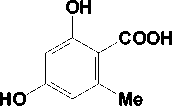
1 Orsellinic acid
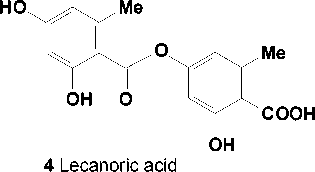
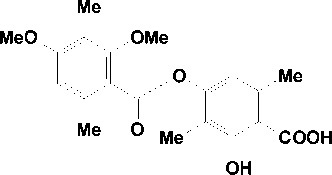
2 Diffractaic acid
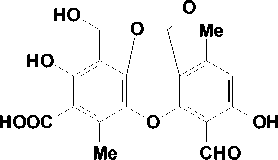
5 Protocetraric acid
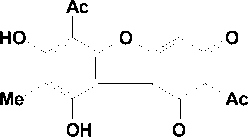
3 Usnic acid
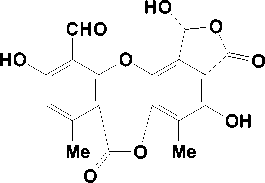
6 Norstictic acid
Figure 1. Six phenolic acids were isolated from lichenized ascomycete Ramalina lacera
Eighteen species of lichens, including Ramalina species, for organic acids have been studied, and distribution of bioactive compounds was described by ZOPF (1907): Ramalina subfarinacea: D-usnic acid and salazinic acid; Ramalina scopulorum: D-usnic acid, and a new compound named scopuloric acid; Ramalina kullensis: D-usnic acid, and a new compound, C22H18O12, called kullensisic acid by the author; Ramalina minuscula: D-usnic acid; Ramalina landroensis: D-usnic acid and an unidentified compound; Ramalina obtusata: D-usnic acid and two new ac- ids, ramalinellic and obtusatic. Usnic acid was also found in other Ramalina species: R. reticulata (STARK et al., 1950), R. diracerata var. obtusata (NAKAO, 1923), R. tingitana (GONZALES et al., 1973), and R. farinacea (TAY et al., 2004).
Table 1
Antibacterial and antifungal activities (MIC values are expressed in µg/mL) of the phenolic metabolites (1-6) isolated from Ramalina lacera
HUZIKAWA and HUSIMI (1941) detected orsellic ester derivates in water extract of unidentified lichen, and showed that orsellic amyl ester and p -hydroxydiphenylmethane showed antiseptic action. More recently, the active constituents isolated from Stereocaulon alpinum and Peltigera aphthosa were identified as methyl β -orsellinate and a mixture of methyl and ethyl orsellinates, and showed activity against Gram-negative bacteria and fungi as well as Gram-positive bacteria (INGOLFSDOTTIR et al. , 1985). The o -orsellinic and p -orsellinic acids gave 50% growth inhibition at a concentration of 6.5 × 10-5 of leprosy bacilli Mycobacterium tuberculosis (LENNARTZ, 1947).
Diffractaic acid ( 2 ) was for the first time isolated from lichens Usnea diffrac-ta , and Evernia mesomorpha f. esoredioso by Asahina and co-workers, in 1932 (ASAHINA and FUZIKAWA, 1932; ASAHINA and FUKUZIRO, 1932; ASAHINA and HIRAKATA, 1932). Later, this acid was identified from many different lichen species and showed biological activity [6]. Ramalina continentalis, Parmotrema tinctorum, Usnea subcavata collected in Mato Grosso do Sul, Brazil, contains diffractaic, usnic, and lecanoric acids which showed activity against the phytopathogenic fungus Cladosporium sphaerospermum (HONDA et al. , 1999). Diffractaic, usnic, and orsellinic acids along with Atranorin and chloroatranorin have been isolated from Ramalina subcomplanata (Usneaceae, collected in Nepal) Brine shrimp bioassay and antibacterial properties of different extracts of R. sub-complanata were also reported (SUNIL KUMAR et al. , 1995). The sensitivity of the human keratinocyte cell line HaCaT to diffractaic, gyrophoric, and usnic acids isolated from Parmelia nepalensis and Parmelia tinctorum was demonstrated (SUNIL KUMAR and MUELLER, 1999). The (+)-usnic acid, and diffractaic acid were potent anti-proliferative agents and inhibited cell growth, with IC 50 values of 2.1, and 2.6 µ M, respectively.
In 1934, protocetraric acid ( 3 ) has been obtained in large yield (12%) from Parmelia zollingeri , together with mannitol, small amounts of atranorin, and traces of lecanoric acid (ASAHINA and TANASE, 1934).
Lecanoric acid ( 4 ) was obtained for the first time from lichen Urceolaria scruposa var. vulgaris by OSWALD HESSE (1907; 1911), and later was discovered from many other lichen species (HUNECK and YOSHIMURA, 1996; DEMBITSKY and TOLSTIKOV, 2005; NIMIS and SKERT, 2006; BRUNAUER and STOCKER-WORGOTTER, 2005). Lecanoric acid inhibited the fungus growth of the phytopathogenic fungus Cladosporium sphaerospermum (HONDA et al. , 1999), and histidine decarboxylase (MATSUMOTO et al. , 2000), and also showed molluscicidal activity against the freshwater snails Bulinus truncatus and Biompha-laria pfeifferi (AYOUB and MAAT, 1986), and antifeedant activity against insect Spodoptera litura (SRIMMANNARAYANA and RAO, 1985).
Protocetraric acid (5 was obtained) for the first time from extract of Evernia furfuraces var. olivetorina (HESSE, 1916), and later was isolated from many other lichens (HUNECK and YOSHIMURA, 1996; DEMBITSKY and TOLSTIKOV, 2005; KLOSA, 1953; HUNECK and FOLLMANN, 1967; ELIX et al., 2002). The depsidone 9'-(O-methyl)protocetraric acid was isolated from the lichen Cladonia convoluta along with the known (-)-usnic acid and fumarprotocetraric acid. (-)-Usnic acid was the only compound to display a moderate cytotoxic activity on various cancer cell lines (IC50 = 6, 12.1, 15.8, 17.8, 8.2 and 6.8 µg/mL on L1210, 3LL, DU145, MCF7, K-562 and U251, respectively), and derivative of protocetraric acid was also shown to induce apoptosis of murine leukemia L1210 cells in a dose- and time-dependent manner (BEZIVIN et al., 2004). Protocetraric acid showed activity only against the tested yeasts Candida albicans and Candida glabrata. The MIC values of the extract as well as of the three substances were described (TAY et al., 2004). Fungistatic effect of protocetraric acid on the growth of Fomes annosus was also reported (TICHY and RYPACEK, 1953).
Norstictinic acid ( 6 ) was discovered in 1934 by Asahina and co-workers, which studied Lobaria pulmonaria lichen from South Sakhalin (ASAHINA and YANAGITA, 1934), Usnea articulata var. asperula (ASAHINA and TSUKAMOTO, 1934), and Parmelia acetabulum (ASAHINA and FUJIKAWA, 1935). More recently, this acid was identified from other lichens (HUNECK and YOSHIMURA, 1996; DEMBITSKY and TOLSTIKOV, 2005; STOCKER-WORGOTTER et al. , 2004; JIANG et al. , 2001; HAMADA et al. , 1997; WAHYUONO and SUDARTO, 1995; RAMESH and ALI BAIG, 1994). Norstic-tinic acid from Lobaria pulmonaria increase enzyme activity of nitrate reductase (SHAPIRO, 1987; SHAPIRO, 1985), and inhibited growth of the polyphagous herbivore Spodoptera littoralis (GIEZ et al. , 1994).
Список литературы Противобактериальная и антифунгицидная активность некоторых фенольных метаболитов, выделенных из лишайникового аскомицета Ramalina lacera.
- Andrews J.M., Boswell F.J., Wise R. 2000. Evaluation of the Oxoid Aura image system for measuring zones of inhibition with the disc diffusion technique. J. Antimicrobial Chemother. 46: 535.
- Asahina A.Y. and Fujikawa F. 1935. Lichen substances. LI. Occurrence of norstictinic acid in Parmelia acetabulum. Chem. Ber. 68B: 946.
- Asahina Y. and Fuzikawa F. 1932. Lichen substances. IX. Diffractaic acid, a barbatinic acid monomethyl ether. Chem. Ber. 65B: 175.
- Asahina Y. and Hirakata T. 1932. Lichen substances. XV. Divaricatic acid. Chem. Ber. 65B: 1665.
- Asahina Y. and Tanase Y. 1934. Lichen substances. XXXVIII. Protocetraric acid and its alkyl ethers. Chem. Ber. 67B: 766.

